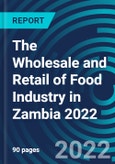Introduction
Large foreign-owned retail chains dominate Zambia’s formal food sector, but an estimated 70% of households buy their food at stalls, informal shops, kiosks, street vendors and markets.Almost 80% of Zambia’s informal workers are employed in agricultural and related activities. Rapid urbanisation and a growing population support further growth and expansion opportunities. The development of supermarket chain stores in Zambia has improved the availability of products and services and has provided more choices for Zambian consumers at competitive prices. However, there are numerous challenges including vulnerability to droughts, high inflation, high levels of poverty and a volatile exchange rate.
Opportunities
Increased local supply of produce because of increased agriculture potential.Increased use of online shopping platforms. Road infrastructure projects could result in improved import and export opportunities. The growing urban population and middle class.
Outlook
Retail chains see the Zambian retail market as important, although they have faced operational challenges. Online shopping is a growing but niche market, currently, and ecommerce is extending retail services to small towns and rural areas where there is limited availability of goods. Revenue in the food sector is expected to grow strongly between 2022-2025 on the back of increased spending supported by increasing economic activity, rising disposable income and growing middle class. Urbanisation will continue to increase, creating more demand and business opportunities in urban areas.Report Coverage
This report focuses on the wholesale and retail food in Zambia and includes information on formal and informal sectors, trade, corporate actions and development, government support and regulations, key trends and influencing factors.There are profiles of 12 companies including South Africa companies present in Zambia such as Shoprite, Pick n Pay and Massmart, Botswana’s Choppies and local companies such as Zambeef.
Strengths
Foreign players already in the country continue to invest in new stores.Formal and informal wholesalers co-exist throughout the country and are able to service a variety of markets. Investors can repatriate dividends, management fees, interests, profits and royalties. There are no restrictions on foreign investment in any sector.
Threats
High inflation can affect disposable incomes.Volatile exchange rate, which has impact on retailers given high levels of imported goods. Vulnerability to climate change will result in persistent droughts that will affect the supply of hydro-electricity and a reduction in agricultural produce.
Weaknesses
Delay of payments by debtors is a common problem particularly from government ministries and parastatals. Distribution of food is hampered by poor road infrastructure, which makes transportation by road unreliable and expensive. High cost of credit finance. Regional supermarket chains dominate the formal wholesale and retail space making it difficult for local companies and SMEs to compete. Shortages of management and technical skills. The sector is reliant on imported foodstuffs.Table of Contents
1. INTRODUCTION2. COUNTRY INFORMATION4. AFRICA5. INTERNATIONAL8. SWOT ANALYSIS9. OUTLOOK10. INDUSTRY ASSOCIATIONS
2. DESCRIPTION OF THE INDUSTRY
3. LOCAL
6. INFLUENCING FACTORS
7. COMPETITIVE ENVIRONMENT
11. REFERENCES
APPENdix
COMPANY PROFILES
Companies Mentioned
- Food Lovers Holdings (Pty) Ltd
- Massmart Holdings (Pty) Ltd
- Melisa Supermarket Ltd
- OMG Group Holdings Ltd
- Promasidor (Zambia) Ltd
- Seapride Foods Zambia Ltd
- Zambeef Products PLC
Methodology

LOADING...








